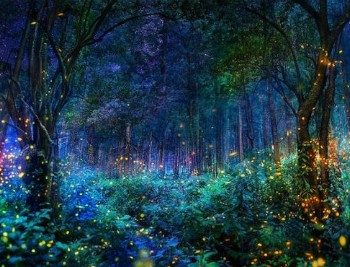This otherworldly locale lies a short distance from Surya Plaza. A weathered trail up towards Koten Temple abruptly veers left towards a verdant overhang, the deciduous forest seemingly growing from the side of Lhavit’s jagged peak. If one chooses to walk the dirt trail, they’ll find themselves in a lavish park infused by wild djed.
By day the scenery is perpetually illuminated by the warm rays of the sun. The ambient light is warm, reflecting hues of rose, orange, and red. By night, those colors shift naturally into varying shades of blue - from deepest navy to fluorescent turquoise. This vivid spectrum adds an ethereal, otherworldy appeal that attracts Lhavit’s seasonal visitors in flocks. The Park is most beautiful during dusk, when the colours of the day begin to bleed into the hues of the night, creating a stunning gradient of light throughout the Park.
 Various native flora and fauna populate Ahleas Park, most notably the fadeong – Lhavit's unique, multi-colored tree. Other commonly known plants are the zujin flowers, leiyona flowers, and the jasao weed. Much of the flora in the Park, as in the rest of Lhavit, is bio-luminescent, and glows with its own light. Bobcats most commonly roam the park’s richly populated avenue, alongside the Alheas lions, mountain cats, deer mice, and countless squirrels.
Various native flora and fauna populate Ahleas Park, most notably the fadeong – Lhavit's unique, multi-colored tree. Other commonly known plants are the zujin flowers, leiyona flowers, and the jasao weed. Much of the flora in the Park, as in the rest of Lhavit, is bio-luminescent, and glows with its own light. Bobcats most commonly roam the park’s richly populated avenue, alongside the Alheas lions, mountain cats, deer mice, and countless squirrels.
The wildlife is relatively harmless and large predators are routinely relocated from within its perimeter by the Shinya for safety reasons. At the very center of the location lies a lovely pond that harbours waterborne plants. Due to the djed influence, the only life within the tranquil water is the nistus jellyfish, a unique species of freshwater jellyfish found only in Alheas Park that tend to stay deep within the water. Various benches crafted from skyglass line the water’s edge, as well as different stops along the park’s spidery pathways. The vivid lights reflect from these seats, casting rainbows across the surrounding surfaces. This creates a wholly incredible scene both during day and night.
One of the park’s main highlights is a special breed of firefly known as the prismfly. Their flickering tails shift color, as opposed to simply lighting up. Drawn by the fadeong that populate the park, the two species share the similar characteristic of being multicoloured; any attempts to relocate the prismfly are met with failure. As all of these features are completely unqiue to Lhavit, the park is garners much attention throughout the year. Despite the non-descript entryway, Ahleas Park’s popularity has increased threefold since its inception. It’s been expanded several times since then. Ahleas is currently 6 acres total, and set to grow. Though new, Ahleas is undeniably gorgeous and has become one of Lhavit’s overarching tourist traps.
One detail of note is the enigmatic Lonely Shack that seems to appear within the park at random. It is said a fortune teller lives there, affectionately dubbed the Alheas Crone.
By day the scenery is perpetually illuminated by the warm rays of the sun. The ambient light is warm, reflecting hues of rose, orange, and red. By night, those colors shift naturally into varying shades of blue - from deepest navy to fluorescent turquoise. This vivid spectrum adds an ethereal, otherworldy appeal that attracts Lhavit’s seasonal visitors in flocks. The Park is most beautiful during dusk, when the colours of the day begin to bleed into the hues of the night, creating a stunning gradient of light throughout the Park.
The wildlife is relatively harmless and large predators are routinely relocated from within its perimeter by the Shinya for safety reasons. At the very center of the location lies a lovely pond that harbours waterborne plants. Due to the djed influence, the only life within the tranquil water is the nistus jellyfish, a unique species of freshwater jellyfish found only in Alheas Park that tend to stay deep within the water. Various benches crafted from skyglass line the water’s edge, as well as different stops along the park’s spidery pathways. The vivid lights reflect from these seats, casting rainbows across the surrounding surfaces. This creates a wholly incredible scene both during day and night.
One of the park’s main highlights is a special breed of firefly known as the prismfly. Their flickering tails shift color, as opposed to simply lighting up. Drawn by the fadeong that populate the park, the two species share the similar characteristic of being multicoloured; any attempts to relocate the prismfly are met with failure. As all of these features are completely unqiue to Lhavit, the park is garners much attention throughout the year. Despite the non-descript entryway, Ahleas Park’s popularity has increased threefold since its inception. It’s been expanded several times since then. Ahleas is currently 6 acres total, and set to grow. Though new, Ahleas is undeniably gorgeous and has become one of Lhavit’s overarching tourist traps.
One detail of note is the enigmatic Lonely Shack that seems to appear within the park at random. It is said a fortune teller lives there, affectionately dubbed the Alheas Crone.




